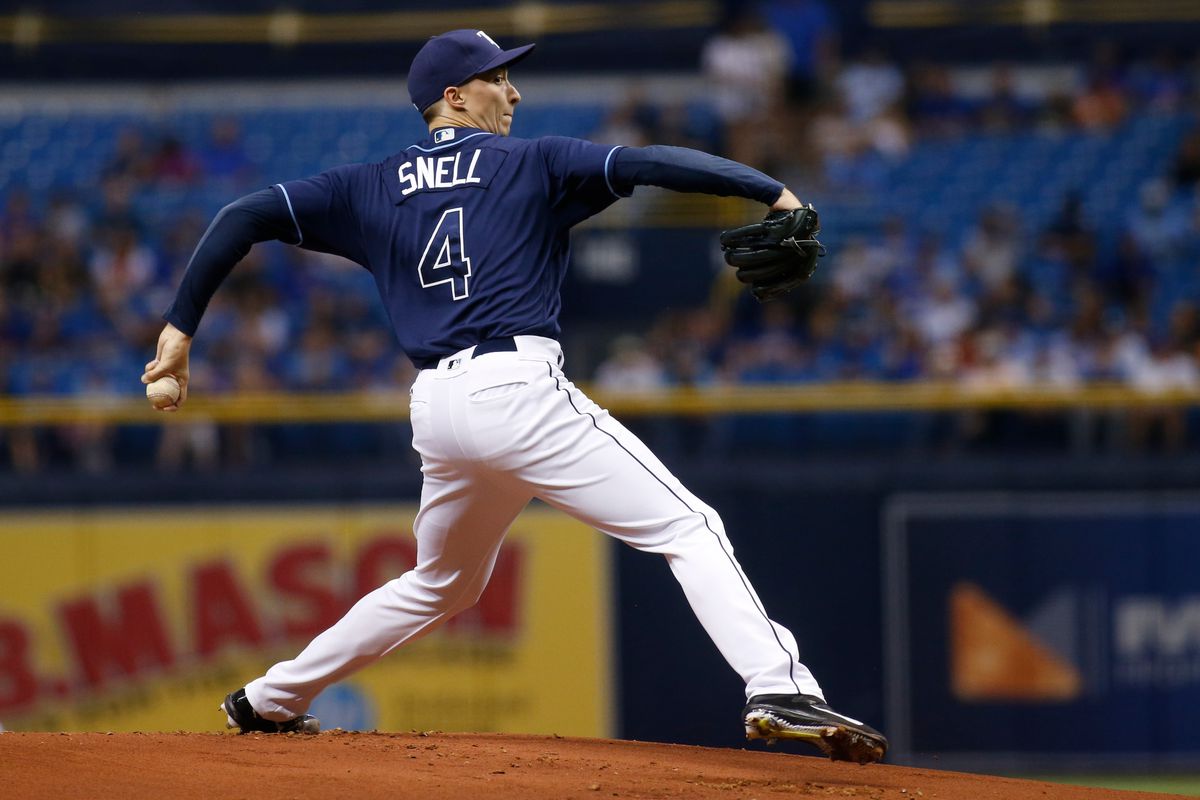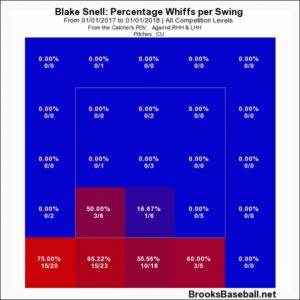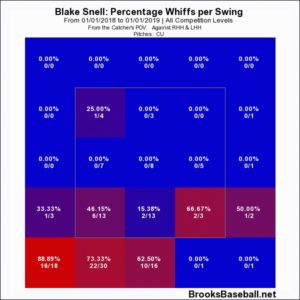Blake Snell’s Slow Rise To The Top

Blake Snell wasn’t on the top of most preseason fantasy rankings. Most of the baseball experts dismissed the Rays’ lefty as a talented but wild mid-rotation starter. They sure didn’t see the dominant 2018 version of Snell coming and are surely kicking themselves for it. Snell has been a stud this year and we know why: he is increasing his K% while decreasing his BB%, to 27.1 % and 8.3%, respectively.
In the minors from 2011 to 2014, Snell posted an impressive 3.37 ERA and 3.71 FIP but the deeper stats told a little bit of a different story. Blake had a 24.5% K rate and and BB% of 12.6%, to with a .311 BABIP, which, over such a large sample size, tells you that hitters were making good contact. Based on the ERA, one would think the Rays would have promoted him quickly, but he only got as far as High A because the team couldn’t trust him to throw strikes.
The big jump came in 2015 when he tore through three levels of the minors (A+, AA, AAA). He decreased his BB% to 10.2% while increasing his K% to 31.3%, which netted him a sparkling 1.41 ERA and 2.71 FIP. Snell was having his coming out party and flashing all his potential for the world to see, earning him Pitching Prospect of the Year (PPOY).
After starting 2016 in AAA- and managing to keep his BB% the same while continuing to increase his K%- he earned a call-up to the majors… a completely different world. Sure enough, Snell began to fall into his old ways. His BB% climbed back to 12.7% and his K% fell to 24.4%. Again, his solid 3.54 ERA was a bit deceiving, relying on an unsustainably low homer rate and an unsustainably high strand rate.
In 2017, the Rays gave him a chance out of spring training to prove that he could replicate the success of his 2015 PPOY performance, but he did not rise to the challenge. His K% plummeted to a career low of 18% and his BB% increased to 13.5%, prompting the Rays to send him back to AAA to work out the kinks. Once recalled though, he dropped his BB% to 10.3% and got his K% above 20%. He was trending in the right direction.
Through his first 15 starts in 2018, Snell is looking like a top-ten pitcher, sporting an ERA of 2.58, WHIP of 1.03, with 97 strikeouts (27.1%) to 29 walks (8.3%). There is a multitude of reasons for why Snell’s stats are finally catching up to the hype now in his third year.
This biggest change we’ve seen this season is in Snell’s curveball usage. It’s up to 16.7%, markedly up from 2016 and 2017, which were 12.71% and 10.3%, respectively. The increased usage comes from cutting back on his slider and changeup, each of those dropping to around 3% since a year ago. Below you can a see a chart from Fangraphs that shows pitch type percentage and (average velocity).
Snell is only getting stronger, smarter, and more comfortable out there on the mound. His average velocity for all of his pitches has increased by one MPH in each of the last two years, which could be part of the reason for the increased success with the breaking stuff.
Last season he leaned heavily on his changeup (21.1%) and slider (13.5%) which only have an 8 MPH differential with his fastball while his curveball has a differential of 15 MPH. Now that he has more confidence in his curveball, he is figuring out how to keep hitters off balance. His curveball has become his best pitch, he is throwing it for strikes and limiting damage. The chart below (from Brooksbaseball.net) shows his performance per pitch type so far this season.
Snell is throwing his curveball for strikes 38.93% and he has also shown the ability to limit damage with this pitch by sporting a 23.28% whiff rate, a low 1.91% flyball rate, and a remarkable 0% HR rate.
Below is a heat map on percentage whiffs per swing on his curveball only, from 2017 (left) and 2018 (right). As you can see there is a lot more red this season and that is a good thing. All of this leads to an increase in swinging strike by 2%. He is simultaneously increasing the number of pitches he throws in the zone while limiting the contact made at a higher rate.
He is still only 25 years old. As long as he is able to keep his walk rate down and still throw the curve for strikes, he will be one of the premier pitchers in the league. He is finally starting to figure out what mix of pitches is most effective and that is a dangerous thing for opposing hitters. Snell’s curveball is that “go to” pitch that is necessary to become an elite starter in the MLB, and maybe even a top trade target for this summer. He is blossoming into a nasty pitcher and he is off to the best start of his young career. While he could be getting lucky, I believe he has become a legit strikeout machine that issues few walks. If this isn’t enough evidence to love Snell, he recently tied a record for striking out seven straight batters to start a game. You will not be disappointed.
-Brendan Cusack




















